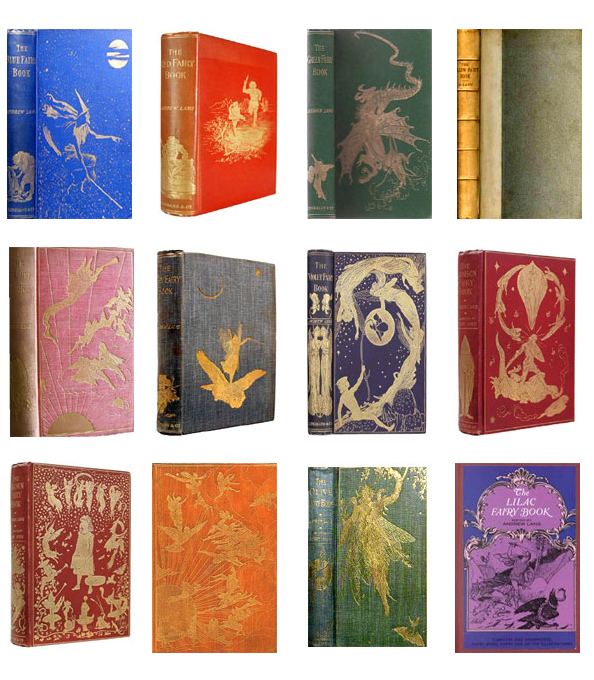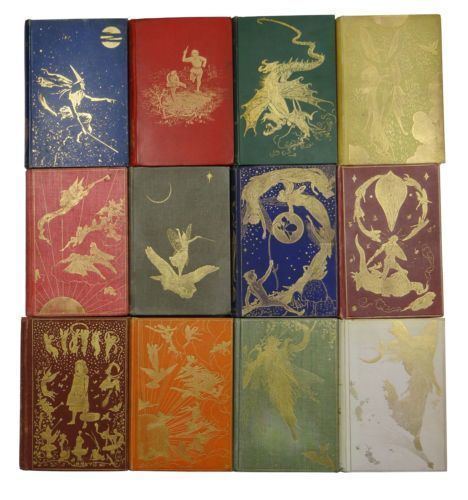No. of books 25 Number of books 12 Genre Fairy tale | Published 1889–1913 | |
 | ||
Books Blue fairy book, The red fairy book, The green fairy book, The Yellow Fairy Book, Pink Fairy Book Similar At the Back of the North Wind, The Day Boy and the Night Girl, Alice's Adventures in Wonderland | ||
Andrew Lang's Fairy Books are a series of twenty-five collections of true and fictional stories for children, published between 1889 and 1913. The best known books of the series are the twelve collections of fairy tales, known as Andrew Lang's "Coloured" Fairy Books or Andrew Lang's Fairy Books of Many Colors. In all, the volumes feature 798 stories, besides the 153 poems in The Blue Poetry Book.
Contents
- Origin and influence
- Sources
- The Blue Fairy Book 1889
- The Red Fairy Book 1890
- The Blue Poetry Book 1891
- The Green Fairy Book 1892
- The True Story Book 1893
- The Yellow Fairy Book 1894
- The Red True Story Book 1895
- The Animal Story Book 1896
- The Pink Fairy Book 1897
- The Arabian Nights Entertainments 1898
- The Red Book of Animal Stories 1899
- The Grey Fairy Book 1900
- The Violet Fairy Book 1901
- The Book of Romance 1902
- The Crimson Fairy Book 1903
- The Brown Fairy Book 1904
- The Red Romance Book 1905
- The Orange Fairy Book 1906
- The Olive Fairy Book 1907
- The Book of Princes and Princesses 1908
- The Red Book of Heroes 1909
- The Lilac Fairy Book 1910
- The All Sorts of Stories Book 1911
- The Book of Saints and Heroes 1912
- The Strange Story Book 1913
- References
Andrew Lang (1844–1912) was a Scots poet, novelist, and literary critic. As acknowledged in the prefaces, although Lang himself made most of the selections, his wife and other translators did a large portion of the translating and retelling of the actual stories. Four of the later volumes (from 1908 to 1912) were published as by "Mrs. Lang".

According to Anita Silvey, "The irony of Lang's life and work is that although he wrote for a profession—literary criticism; fiction; poems; books and articles on anthropology, mythology, history, and travel ... he is best recognized for the works he did not write."

The twelve Coloured Fairy Books were illustrated by H. J. Ford (Henry Justice Ford), the first Two volumes shared with G. P. Jacomb-Hood and Lancelot Speed respectively, the sequels alone. Several other volumes were illustrated by Ford. A. Wallis Mills also contributed some illustrations.

Origin and influence

The most well-known volumes of the series are the twelve Fairy Books, each of which is distinguished by its own color. Although Lang did not collect any Fairy tales himself from oral primary sources, only he and Madame d'Aulnoy (1651–1705) have collected tales from such a large variety of sources. These collections have been immensely influential; Lang gave many of the tales their first appearance in English. As acknowledged in the prefaces, although Lang himself made most of the selections, his wife and other translators did a large portion of the translating and retelling of the actual stories.
Lang's urge to gather and publish fairy tales was rooted in his own experience with the folk and fairy tales of his home territory along the English-Scottish border. At the time he worked, English fairy-tale collections were rare: Dinah Maria Mulock Craik's The Fairy Book (1869) was a lonely precedent. When Lang began his efforts, he "was fighting against the critics and educationists of the day", who judged the traditional tales' "unreality, brutality, and escapism to be harmful for young readers, while holding that such stories were beneath the serious consideration of those of mature age". Over a generation, Lang's books worked a revolution in this public perception.
The series was immensely popular, helped by Lang's reputation as a folklorist, and by the packaging device of the uniform books. The series proved of great influence in children's literature, increasing the popularity of fairy tales over tales of real life. It inspired such imitators as English Fairy Tales (1890) and More English Fairy Tales (1894) by Joseph Jacobs. Other followers included the American The Oak-Tree Fairy Book (1905), The Elm-Tree Fairy Book (1909) and The Fir-Tree Fairy Book (1912), series edited by Clifton Johnson and the collections of Kate Douglas Wiggin and Nora Archibald Smith.
Sources
Some of Lang's collected stories were included without any attribution at all (e.g., "The Blue Mountains"), and the rest are listed with brief notes. When this is "Grimm" or "Madame d'Aulnoy" or attributed to a specific collection, the stories can be tracked down, but other notes are less helpful. For instance, "The Wonderful Birch" is listed only as "From the Russo-Karelian".
Lang repeatedly explained in the prefaces that the tales he told were all old, and not his, and that he found new fairy tales no match for them:
The collections were specifically intended for children, and, as Lang explained in the prefaces to the books, bowdlerised. J. R. R. Tolkien, in his essay "On Fairy-Stories" (1939) stated that while he appreciated the collections, he objected to his editing the stories for children. He also criticized Lang for including stories without magical elements in them, with "The Heart of a Monkey" given as an example. Here, unlike "The Giant Who Had No Heart in His Body" or other similar stories, the Monkey merely claims that his heart is outside his body. However, many fairy tale collectors include tales with no strictly marvelous elements.
The Blue Fairy Book (1889)
The first edition consisted of 5000 copies, which sold for 6 shillings each. The book assembled a wide range of tales, with seven from the Brothers Grimm, five from Madame d'Aulnoy, three from the Arabian Nights, and four Norwegian fairytales, among other sources. The Blue Fairy Book was the first volume in the series, and so it contains some of the best known tales, taken from a variety of sources.
Media related to Blue Fairy Book at Wikimedia Commons
The Red Fairy Book (1890)
It appeared at Christmas 1890 in a first printing of 10,000 copies. Sources include French, Russian, Danish, and Romanian tales as well as Norse mythology.
The Blue Poetry Book (1891)
Contains 153 poems by great English and American poets.
The Green Fairy Book (1892)
In his Preface to this volume, Lang expressed the view that it would be "probably the last" of the collection. Their continuing popularity, however, demanded subsequent collections. In The Green Fairy Book, the third in the series, Lang has assembled stories from Spanish and Chinese traditions.
The True Story Book (1893)
Contains twenty-four true stories, mainly drawn from European history.
The Yellow Fairy Book (1894)
Its initial printing was 15,000 copies. The Yellow Fairy Book is a collection of tales from all over the world. It features many tales from Hans Christian Andersen.
The Red True Story Book (1895)
Contains thirty true stories, mainly drawn from European history. Includes the life of Joan of Arc and the Jacobite uprising of 1745.
The Animal Story Book (1896)
Contains sixty-five stories about animals. Some of them are simple accounts of how animals live in the wild. Others are stories about pets, or remarkable wild animals, or about hunting expeditions. Many are taken from Alexandre Dumas.
The Pink Fairy Book (1897)
Forty-one Japanese, Scandinavian, and Sicilian tales.
The Arabian Nights' Entertainments (1898)
Contains thirty-four stories from the Arabian Nights, adapted for children. The story of Aladdin is in this volume as well as in the Blue Fairy Book.
The Red Book of Animal Stories (1899)
Contains forty-six stories about real and mythical animals. Some of them are simple accounts of how animals live in the wild. Others are stories about pets, or remarkable wild animals, or about hunting expeditions.
The Grey Fairy Book (1900)
Thirty-five stories, many from oral traditions, and others from French, German and Italian collections.
The Violet Fairy Book (1901)
Roumania, Japan, Serbia, Lithuania, Africa, Portugal, and Russia are among the sources of these 35 stories that tell of a haunted forest, chests of gold coins, a magical dog, and a man who outwits a dragon.
The Book of Romance (1902)
Contains nineteen stories from various medieval and Renaissance romances of chivalry, adapted for children. Includes stories about King Arthur, Charlemagne, William of Orange, and Robin Hood.
The Crimson Fairy Book (1903)
These 36 stories originated in Hungary, Russia, Finland, Iceland, Tunisia, the Baltic, and elsewhere.
The Brown Fairy Book (1904)
The Brown Fairy Book contains stories from the American Indians, Australian Bushmen and African Kaffirs, and from Persia, Lapland, Brazil, and India.
Media related to Brown Fairy Book at Wikimedia Commons
The Red Romance Book (1905)
Contains twenty-nine stories from various medieval and Renaissance romances of chivalry, adapted for children. Includes stories about Don Quixote, Charlemagne, Bevis of Hampton and Guy of Warwick.
The Orange Fairy Book (1906)
Includes 33 tales from Jutland, Rhodesia, Uganda, and various other European traditions.
The Olive Fairy Book (1907)
The Olive Fairy Book includes unusual stories from Turkey, India, Denmark, Armenia, the Sudan, and the pen of Anatole France.
The Book of Princes and Princesses (1908)
Published by Longmans as written by "Mrs. Lang"; illustrated by H. J. Ford (LCCN 08-28404).
Contains fourteen stories about the childhoods of European monarchs, including Napoleon, Elizabeth I, and Frederick the Great.
The Red Book of Heroes (1909)
Published by Longmans as written by "Mrs. Lang"; illustrated by H. J. Ford (LCCN 09-17962).
Contains twelve true stories about role models for children, including Hannibal, Florence Nightingale, and Saint Thomas More.
The Lilac Fairy Book (1910)
The Lilac Fairy Book contains stories from Portugal, Ireland, Wales, and points East and West.
The All Sorts of Stories Book (1911)
Published by Longmans as written by "Mrs. Lang"; illustrated by H. J. Ford (LCCN 11-27934).
Contains thirty stories on a variety of subjects, including true stories, Greek myths, and stories from Alexandre Dumas, Walter Scott and Edgar Allan Poe.
The Book of Saints and Heroes (1912)
Published by Longmans as written by "Mrs. Lang"; illustrated by H. J. Ford (LCCN 12-24314).
Contains twenty-three stories about saints. Most of these are true stories, although a few legends are also included.
The Strange Story Book (1913)
Published after Andrew Lang's death, with an introduction by Mrs. Lang. Contains thirty-four stories on a variety of subjects, including ghost stories, Native American legends, true stories, and tales from Washington Irving.
